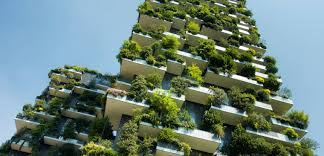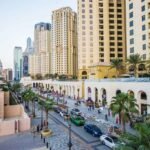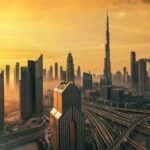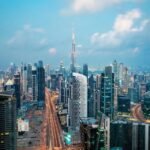Now Reading: Eco-Friendly Real Estate: UAE’s Shift Towards Sustainable Developments in 2025
-
01
Eco-Friendly Real Estate: UAE’s Shift Towards Sustainable Developments in 2025
Eco-Friendly Real Estate: UAE’s Shift Towards Sustainable Developments in 2025

Table of Contents
Sustainable Real Estate Development: Building a Greener Future
Eco-Friendly Real Estate: Sustainable real estate development refers to the practice of designing, constructing, and operating buildings and communities in a manner that is environmentally responsible, socially beneficial, and economically viable. This approach aims to minimize negative impacts on the planet while enhancing the well-being of occupants and ensuring long-term value. As global awareness of climate change and resource scarcity grows, sustainable practices are becoming increasingly integral to the real estate sector.

Key Pillars of Sustainable Real Estate Development:
Sustainable development in real estate typically revolves around three core pillars:
- Environmental Sustainability: This focuses on reducing the ecological footprint of buildings. Key aspects include:
- Energy Efficiency: Designing buildings that consume less energy through passive design strategies (e.g., orientation, natural ventilation, daylighting), high-performance insulation, energy-efficient windows, and the use of renewable energy sources like solar power.
- Water Conservation: Implementing measures such as rainwater harvesting, greywater recycling, water-efficient fixtures, and sustainable landscaping to reduce water consumption.
- Waste Reduction and Management: Minimizing construction waste through efficient material use and recycling, and incorporating systems for effective waste segregation and management during the building’s operational phase.
- Sustainable Materials: Prioritizing the use of locally sourced, recycled, renewable, and low-impact materials that have lower embodied energy and fewer harmful chemicals.
- Biodiversity Protection: Designing projects that minimize disruption to existing ecosystems, preserve natural habitats, and incorporate green spaces like parks, green roofs, and living walls.
- Social Sustainability: This emphasizes the well-being of the people who live and work in the buildings and surrounding communities. It includes:
- Health and Well-being: Creating healthy indoor environments with good air quality, ample natural light, thermal comfort, and non-toxic materials. Promoting active lifestyles through design (e.g., accessible stairs, bicycle storage).
- Community and Connectivity: Fostering a sense of community through inclusive design, providing shared amenities, and ensuring good connectivity to public transport, essential services, and green spaces.
- Accessibility and Inclusivity: Designing buildings that are accessible to people of all ages and abilities.
- Affordability: Considering the provision of affordable housing options within larger developments where appropriate.
- Economic Sustainability (Governance & Viability): This ensures that sustainable practices are financially feasible and contribute to long-term economic value. This involves:
- Lifecycle Costing: Considering the long-term operational savings from energy and water efficiency when evaluating project costs, rather than just initial construction costs.
- Green Finance: Increasing availability and use of financial products and incentives for sustainable projects.
- Resilient Infrastructure: Building structures that can withstand the impacts of climate change, such as extreme weather events.
- Circular Economy Principles: Designing for durability, adaptability, and the potential for future reuse or recycling of building components.
- Enhanced Asset Value: Sustainable buildings often command higher rental or resale values due to lower operating costs, better occupant satisfaction, and improved brand reputation.
Current Trends Shaping Sustainable Real Estate (as of May 2025):

- Net-Zero Buildings: A growing ambition to design buildings that produce as much energy as they consume annually.
- Green Building Certifications: Increased adoption of standards like LEED (Leadership in Energy and Environmental Design), BREEAM (Building Research Establishment Environmental Assessment Method), and in India, GRIHA (Green Rating for Integrated Habitat Assessment), which provide frameworks and verification for sustainable building practices.
- Smart Technology Integration: Utilizing IoT devices, building management systems (BMS), and AI to optimize energy consumption, water usage, and overall building performance.
- Focus on Embodied Carbon: Growing awareness and efforts to reduce the carbon emissions associated with manufacturing, transporting, and installing building materials.
- Health and Wellness Standards: Certifications like the WELL Building Standard are gaining traction, focusing specifically on human health and well-being within the built environment.
- Climate Resilience: Designing buildings and infrastructure to be resilient to the impacts of climate change, such as flooding, heatwaves, and storms.
- PropTech for Sustainability: Leveraging technology startups that offer innovative solutions for energy management, waste reduction, and sustainable operations.
- Sustainable Finance and ESG: Increasing pressure from investors and financial institutions for Environment, Social, and Governance (ESG) criteria to be integrated into real estate projects.
Benefits of Sustainable Real Estate Development:
- Reduced Operating Costs: Significant savings on energy and water bills.
- Enhanced Property Value and Marketability: Growing demand for green buildings leads to higher asset values and quicker sales or leases.
- Improved Occupant Health and Productivity: Better indoor environmental quality contributes to the well-being and performance of occupants.
- Environmental Protection: Conservation of natural resources, reduced pollution, and mitigation of climate change.
- Regulatory Compliance and Future-Proofing: Meeting current and anticipating future environmental regulations.
- Stronger Brand Reputation and Corporate Social Responsibility: Demonstrating a commitment to sustainability enhances brand image.
Challenges in Sustainable Real Estate Development:
- Higher Upfront Costs: While lifecycle costs are often lower, initial investment for sustainable technologies and materials can be higher.
- Lack of Awareness and Expertise: A need for more skilled professionals and greater awareness among developers and consumers.
- Policy and Regulatory Gaps: While improving, consistent and robust policy support and incentives are still evolving in many regions.
- Market Demand and Valuation: Ensuring that the market accurately values the benefits of sustainable features.
- Measuring and Verifying Sustainability: Complexity in accurately measuring and verifying the sustainability performance of buildings over their lifecycle.
In conclusion, sustainable real estate development is no longer a niche concept but a fundamental shift in how we design, build, and live. Driven by environmental imperatives, occupant demand, and increasing investor focus on ESG criteria, it offers a pathway to creating healthier, more resilient, and economically sound communities for the future.
Sustainable Real Estate Development: Building a Greener Future

Sustainable real estate development refers to the practice of designing, constructing, and operating buildings and communities in a manner that minimizes environmental impact, conserves resources, and promotes the long-term well-being of both people and the planet. It’s a holistic approach that considers the entire lifecycle of a property, aiming to create spaces that are not only eco-friendly but also economically viable and socially responsible.
This approach is rapidly moving from a niche interest to a mainstream expectation, driven by growing environmental awareness, stricter regulations, and increasing demand from investors and occupants for healthier, more efficient buildings.
Key Principles Guiding Sustainable Real Estate Development:
Sustainable development in real estate is built upon several core principles:
- Energy Efficiency: Minimizing energy consumption through passive design strategies (e.g., building orientation, natural ventilation, daylighting), high-performance building envelopes, energy-efficient appliances and lighting (like LEDs), and the integration of renewable energy sources such as solar panels.
- Water Conservation: Implementing measures to reduce water usage, such as low-flow fixtures, rainwater harvesting systems, greywater recycling, and water-efficient landscaping.
- Sustainable and Locally Sourced Materials: Prioritizing the use of eco-friendly, recycled, renewable, and non-toxic building materials with low embodied carbon. Sourcing materials locally helps reduce transportation emissions and supports local economies.
- Waste Reduction and Management: Minimizing construction waste through efficient design and planning, promoting recycling and reuse of materials, and implementing effective waste management strategies during the building’s operational phase.
- Optimizing Site Potential: Selecting sites that minimize environmental disruption, promote biodiversity (e.g., through green roofs and preserved natural areas), and encourage sustainable transportation options by being close to public transport and amenities.
- Indoor Environmental Quality (IEQ): Enhancing the health and comfort of occupants through improved indoor air quality (via proper ventilation and use of low-VOC materials), access to natural light and views, and good acoustic design.
- Climate Resilience and Adaptation: Designing buildings and infrastructure that can withstand the impacts of climate change, such as extreme weather events, rising sea levels, and temperature fluctuations.
- Social Equity and Community Well-being: Creating developments that are inclusive, accessible, and contribute positively to the surrounding community, often incorporating green spaces, communal facilities, and promoting a sense of community.
Benefits of Sustainable Real Estate Development:
Adopting sustainable practices in real estate offers a wide array of benefits:
- Environmental Benefits:
- Reduced greenhouse gas emissions and carbon footprint.
- Conservation of natural resources like water and energy.
- Minimized waste and pollution.
- Protection and enhancement of biodiversity.
- Economic Benefits:
- Lower operational costs due to reduced energy and water consumption.
- Increased property values and rental premiums.
- Attraction of environmentally conscious tenants and investors (ESG focus).
- Access to green financing and potential government incentives.
- Enhanced marketability and brand reputation.
- Future-proofing assets against stricter environmental regulations and climate risks.
- Social Benefits:
- Improved occupant health, well-being, and productivity.
- Creation of more resilient and liveable communities.
- Enhanced quality of life through better design and access to green spaces.
Current Trends in Sustainable Real Estate (as of 2025):
The field of sustainable real estate is continuously evolving. Key trends include:
- Increased Demand for Green Certifications: Standards like LEED (Leadership in Energy and Environmental Design), BREEAM (Building Research Establishment Environmental Assessment Method), WELL Building Standard, and India’s IGBC (Indian Green Building Council) ratings are becoming crucial for market differentiation and demonstrating sustainability commitments.
- Integration of Smart Technology: Smart building systems for optimizing energy use, water management, lighting, and HVAC (Heating, Ventilation, and Air Conditioning) are becoming standard. AI-driven analytics are also being used to enhance building performance.
- Focus on Net-Zero Buildings: Growing ambition to design and construct buildings that produce as much energy as they consume annually.
- Embodied Carbon Reduction: Increasing attention to the carbon emissions associated with manufacturing, transporting, and installing building materials.
- Climate Resilience in Design: Proactive measures to ensure buildings can withstand future climate impacts, such as flood-resistant designs and heat-mitigation strategies.
- Growth of Mixed-Use Developments: Creating integrated communities where people can live, work, and play, reducing reliance on cars and promoting walkability.
- Circular Economy Principles: Designing for deconstruction and reuse of materials at the end of a building’s life.
- Wellness and Health: A heightened focus on occupant health, driven partly by the pandemic, leading to designs that prioritize air quality, natural light, and biophilic elements (incorporating nature).
Sustainable Real Estate in India:
India is witnessing a significant shift towards sustainable real estate, driven by government initiatives, urbanization challenges, and growing environmental concerns.
- Green Building Momentum: India is among the top countries for green building development. There’s a surge in green-certified office spaces, and the trend is expanding to residential, retail, healthcare, and data center properties.
- Government Push: Initiatives like the Smart Cities Mission, Pradhan Mantri Awas Yojana (PMAY) with its focus on sustainable materials, and policies promoting renewable energy are catalyzing sustainable practices. The Real Estate (Regulation and Development) Act (RERA) also encourages transparency and quality, indirectly supporting better building practices.
- Investor Interest: Growing interest from domestic and international investors focused on Environmental, Social, and Governance (ESG) criteria is driving developers to adopt sustainable features. Green-certified buildings often command higher rentals and attract institutional investors.
- Retrofitting Existing Buildings: Significant potential is seen in retrofitting older buildings to meet green standards, enhancing their energy efficiency and lifespan.
- Focus on Water Efficiency: Given India’s water scarcity issues, water conservation technologies and practices are critical components of sustainable development.
Challenges in Sustainable Real Estate Development:
Despite the numerous benefits and growing momentum, several challenges remain:
- Higher Upfront Costs: Sustainable materials and technologies can sometimes have higher initial investment costs, though these are often offset by lower operational costs over time.
- Lack of Awareness and Expertise: A need for greater awareness and skilled professionals (architects, engineers, contractors) versed in sustainable design and construction techniques.
- Regulatory Hurdles: While improving, building codes and regulations may not always be fully aligned with or incentivizing the latest sustainable practices.
- Access to Sustainable Materials and Technologies: Availability and cost of certain green materials and advanced technologies can be a constraint in some regions.
- Limited Green Financing Options: While growing, dedicated financial products and incentives for sustainable projects need further development and accessibility.
- Market Perception and Valuation: Ensuring that the long-term value of sustainable features is accurately reflected in property valuations.
Illustrative Examples:
- Global:
- The Sustainable City, Dubai, UAE: A pioneering project designed for net-zero energy, producing its own food, and emphasizing waste recycling and water efficiency.
- Kampung Admiralty, Singapore (by WOHA Architects): An integrated public development that combines housing for seniors with healthcare, social, commercial, and childcare facilities, featuring lush greenery and energy-efficient design.
- Bosco Verticale, Milan, Italy (and Medellín, Colombia): Residential towers incorporating extensive vertical forests that improve air quality, reduce urban heat, and promote biodiversity.
- General Concepts:
- Green Roofs and Walls: Vegetation on roofs and facades that helps insulate buildings, manage stormwater, improve air quality, and create habitats.
- Prefabricated and Modular Construction: Can reduce waste, improve quality control, and shorten construction times.
- Use of Eco-Friendly Materials: Bamboo, reclaimed wood, recycled steel, low-emission paints, and locally sourced materials.
The Road Ahead:
Sustainable real estate development is no longer a mere trend but a fundamental shift in how we envision, create, and interact with the built environment. As climate change imperatives intensify and societal expectations evolve, the integration of sustainability principles will become increasingly critical for the long-term viability, resilience, and positive impact of real estate projects worldwide. The future will likely see even greater innovation in materials, technology, and design, further pushing the boundaries of what it means to build sustainably.
WATCH MORE HERE:https://www.instagram.com/reel/DGyIIEANmiD/
READ MORE ABOUT THIS: Affordable Housing Initiatives in the UAE: Building Inclusive Communities for 2025






















